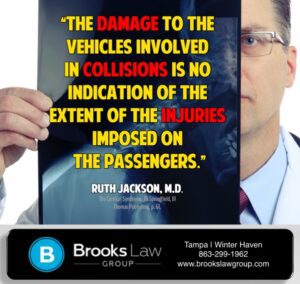
If emergency services respond to an accident here in Tampa, they assess victims for immediately evident injuries like fractures, head trauma, serious abrasions, or burns, and then determine if further medical treatment is necessary. In some cases, EMTs send victims to nearby Tampa General Hospital if they suspect internal injuries or if the victim had even minor head trauma (as this can turn serious quickly). But, what if you seem okay after your accident? Could you still be hiding injuries that are missed during your initial examination?
Unfortunately, yes. There are many injuries that might not show up for days, weeks, or even months after your accident. It’s important to recognize that, according to Ruth Jackson, M.D., “The damage to the vehicles involved in collisions is no indication of the extent of the injuries imposed on the passengers.” What does that mean? It means you can walk away from a seemingly minor accident with serious injuries that aren’t obvious to onlookers or first responders. One of the most common injuries that falls under this category is whiplash.
What is whiplash?
Whiplash is, according to Mayo Clinic, “a neck injury due to a forceful, rapid back-and-forth movement of the neck” and doctors often see it after vehicle collisions or any accident involving strong impact to an individual. We would liken the motion to that of a whip cracking, and it can cause extensive pain and suffering for a victim for years after their accident.
What are the symptoms of whiplash?
Common whiplash symptoms include:
- Neck pain, stiffness, or decreasing range of motion
- Headaches (usually located at the base of the skull)
- Pain and stiffness in the shoulders, upper arms, or upper back
- Tingling or numbness in the neck, back, shoulders, or arms
- Fatigue
- Dizziness
Additional symptoms, although less routine, include:
- blurry vision
- tinnitus (ringing in the ears)
- trouble sleeping
- irritability, depression, and/or mood swings
- difficulty with concentration or memory
 Unfortunately, many of these symptoms take time to notice, and might not raise red flags immediately following an accident where pain and stiffness are an expected side effect. If you notice any of these symptoms, what should you do?
Unfortunately, many of these symptoms take time to notice, and might not raise red flags immediately following an accident where pain and stiffness are an expected side effect. If you notice any of these symptoms, what should you do?
You should schedule an appointment as soon as possible with your healthcare practitioner. He or she will be able to listen to your concerns, examine your neck, and schedule any needed x-rays, MRIs, and/or CT scans to determine the severity of your injury and the best treatment protocols moving forward.
Once you have a diagnosis, what comes next?
For victims who have whiplash as the result of an accident that wasn’t their fault, there’s an opportunity for seeking justice and compensation to aid in recovery and medical care. If you suspect that your injuries are the result of someone else’s recklessness or negligence, you should be mindful of any and all medical appointments, tests, and treatments related to the injury. Schedule your free consultation with Brooks Law Group and bring this information to discuss with your lawyer. Our team uses this information, along with our extensive experience in representing whiplash victims, to fight for the help you deserve. Don’t continue to suffer in silence or take on the fight alone. We’re here to help Tampa’s accident victims. When you don’t know where to turn, Look to Brooks.













